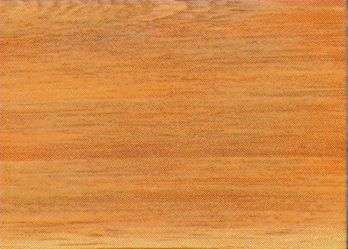
Nkoba (Baikiaea insignis)
Family: Leguminosae
Common names: Nkoba, Nkobakoba
Distributed in: Tanzania, Uganda (Africa)
Common uses: Agricultural implements, Boat building (general), Cabinetmaking, Carvings, Concrete formwork, Flooring, Flooring: industrial heavy traffic, Furniture, Heavy construction, Joinery, Light construction, Paneling, Piling, Plywood, Railroad ties, Veneer
Product sources: The ITTO reports that timber from this species is produced and exported only in low volumes.
Environment profile: Abundant/Secure
Tree size: Trunk diameter is 100-150 cm
Colors: the heart isYellow, Yellow to golden-yellow to orangeand the sapwoodWhite, Yellow.The grain isStraight, the textureMediumand the lusterMedium
Natural durability: Susceptible to marine borer attack, Very durable
Odor: Has an odor
LightInduced Color Change: Lighter
Kiln Schedules: UK=D US=T3D2/T3C1
Kiln Drying Rate: Slow (18-28 days for boards < 32 mm, to 52-84 days for boards >= 63 mm)
Drying Defects: Severe twisting/warping, Slight surface checking
Ease of Drying: Slowly
Tree Identification: Bole/stem form is misshapen
Blunting Effect: High to severe
Boring: Moderately easy
Carving: Fair to Good Results
Cutting Resistance: Easy to saw
Gluing: Fairly Easy to Very Easy
Mortising: Finishes satisfactorily
Moulding: Good finishing
Movement in Service: Good finishing
Nailing: Fair to Good , Very Good to Excellent
Planing: Fairly Difficult to Very Difficult
Resistance to Impregnation: Sapwood is moderately resistant
Resistance to Splitting: Satisfactory
Response to hand tools: Easy to machine
Routing recessing: Fair to Good Results
Veneering qualities: Suitable for peeling, Suitable for slicing
Screwing: Fair to Good Results, Very Good to Excellent Results; Turning: Fair to Good Results
Painting: Good; Polishing: Good; Staining: Reacts with Iron to discolour wood;
- Numerical data Metric
- Numerical data English
- Strength properties
- References
 |
 |
 |
 |
| Item |
Green |
Dry |
Metric |
| Specific Gravity |
|
|
|
| Density |
|
769 |
kg/m3 |
| Bending Strength |
654 |
1024 |
kg/cm2 |
| Crushing Strength |
485 |
699 |
kg/cm2 |
| Hardness |
|
752 |
kg |
| Impact Strength |
|
|
cm |
| Shearing Strength |
|
124 |
kg/cm2 |
| Stiffness |
140 |
161 |
1000 kg/cm2 |
| Tangential Shrinkage |
|
|
% |
| Radial Shrinkage |
3 |
|
% |
| Weight |
753 |
608 |
kg/m3 |
| Maximum Load |
|
|
cm-kg/cm3 |
| Toughness |
|
|
cm-kg |
| Static Bending |
|
|
kg/cm2 |
|
 |  |  |  | | Item | Green | Dry | English | | Bending Strength | 9310 | 14566 | psi | | Density | | 48 | lbs/ft3 | | Hardness | | 1658 | lbs | | Maximum Crushing Strength | 6899 | 9945 | psi | | Shearing Strength | | 1775 | psi | | Stiffness | 1999 | 2304 | 1000 psi | | Weight | 47 | 38 | lbs/ft3 | | Radial Shrinkage | 3 | | % | | Tangential Shrinkage | 6 | | % | |
Density (dry weight) = 46-52 lbs/cu. ft. 0
Max. crushing strength = high
Bending strength (MOR) = medium
Shrinkage, Radial = small
Shrinkage, Tangential = moderate
Shearing strength (parallel to grain) = low
Modulus of Elasticity (stiffness) = high
Hardness (side grain) = medium
Shrinkage, Radial = very small
Shrinkage, Tangential = very small
Shearing strength (parallel to grain) = medium
Modulus of Elasticity (stiffness) = medium
Density (dry weight) = 53-60 lbs/cu. ft
Shrinkage, Tangential = small
Banks, C.H., Schoeman, J.P., Otto, K.P.,1977,The Mechanical Properties of Timbers with particular reference to South,Africa,South African Forestry Research Institute Bulletin,(Ed.,Schoeman, J.P. 1973 & Otto K.P. 1976,No.48Bolza, E., Keating, W.G.,1972,African Timbers - the Properties, Uses and Characteristics of 700 Species,C.S.I.R.O. Div. of Building ResearchChudnoff, M.,1984,Tropical Timbers of the World,U.S.A. Department of Agriculture, Forest Service, Forest Products,Laboratory, Madison.Eggeling, W.J.,1940,Indigenous Trees of Uganda,Govt. Printer Entebbe UgandaI.U.F.R.O.,1973,Veneer Species of the World,Assembled at F.P.L. Madison on behalf of I.U.F.R.O. Working Party on,Slicing and Veneer CuttingMurira, K.,1984,Natural Durability Tests of Tanzanian Timbers 1955 - 1982,Tanzania Forestry Research Institute, Timber Utilisation Research Centre,,Moshi.Tack, C.H.,1958,The Strength Properties of some Uganda Timbers,Uganda Forest Department Bulletin No. 5Tack, C.H.,1969,Uganda Timbers,Govt. Printer UgandaTakahashi, A.,1978,Compilation of Data on the Mechanical Properties of Foreign Woods (Part,III) Africa,Shimane University, Japan, Research Report on Foreign Wood No. 7Tanzania Forest Department,1960,The Natural Durability of Local Timbers,Tanzanian Forest Dept. Tech. Note,No.14Tanzania Forest Division,1966,Kiln Drying Schedules for Tanzania Timbers Technical Note no.38,Tanzania Forest Div. Util. Sec. MoshiTanzania Forestry Department,1961,Timbers of Tanganyika - Baikiaeae insignis,Tanzania Forestry Department, Utilisation Section, Moshi - Timbers of,TanganyikaUganda Forest Department,1969,The Shrinkage of Some Ugandan Timbers,Uganda Forestry Department Timber Leaflet,No.47
|








